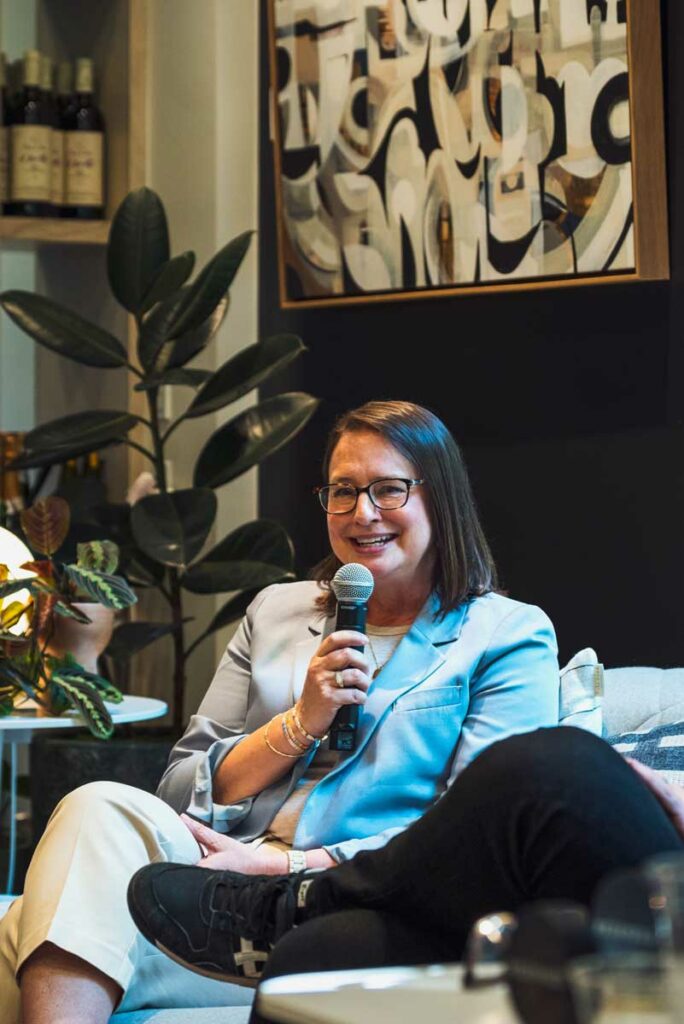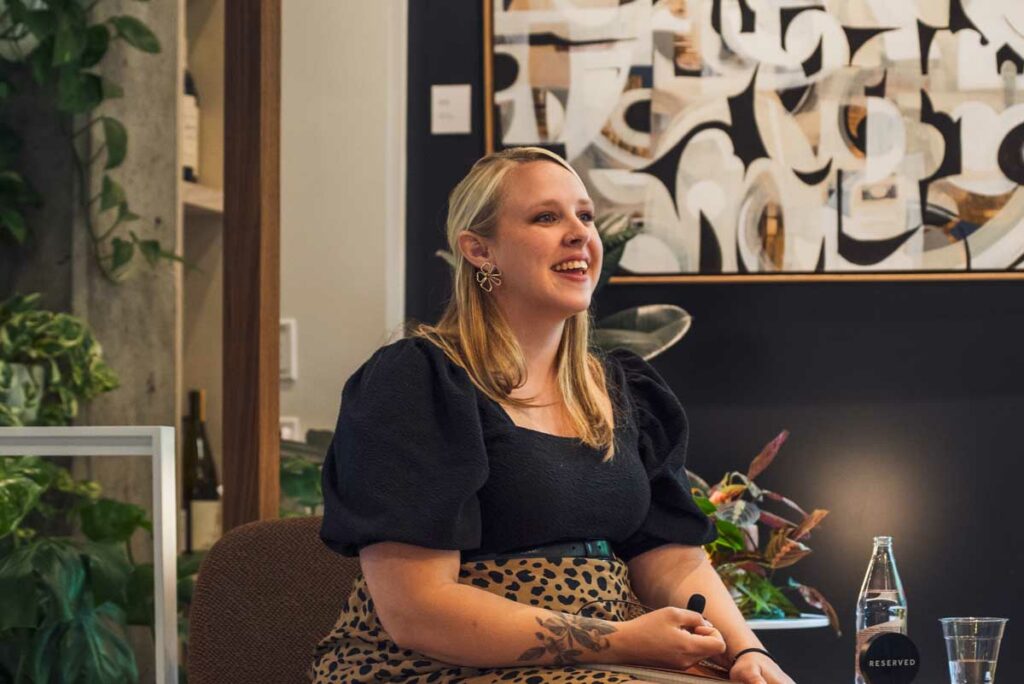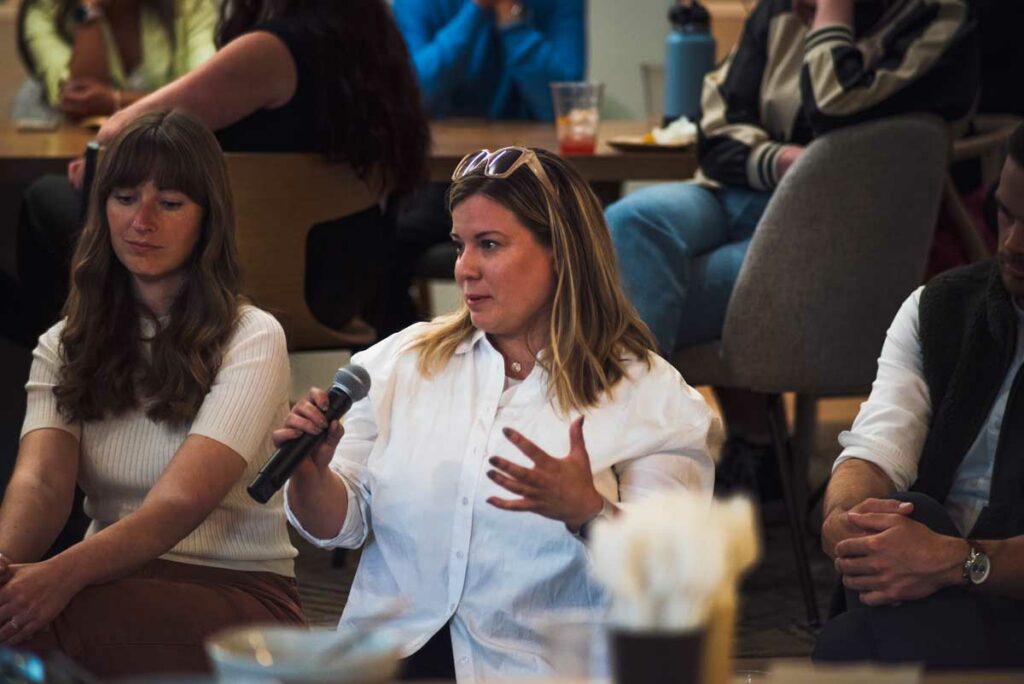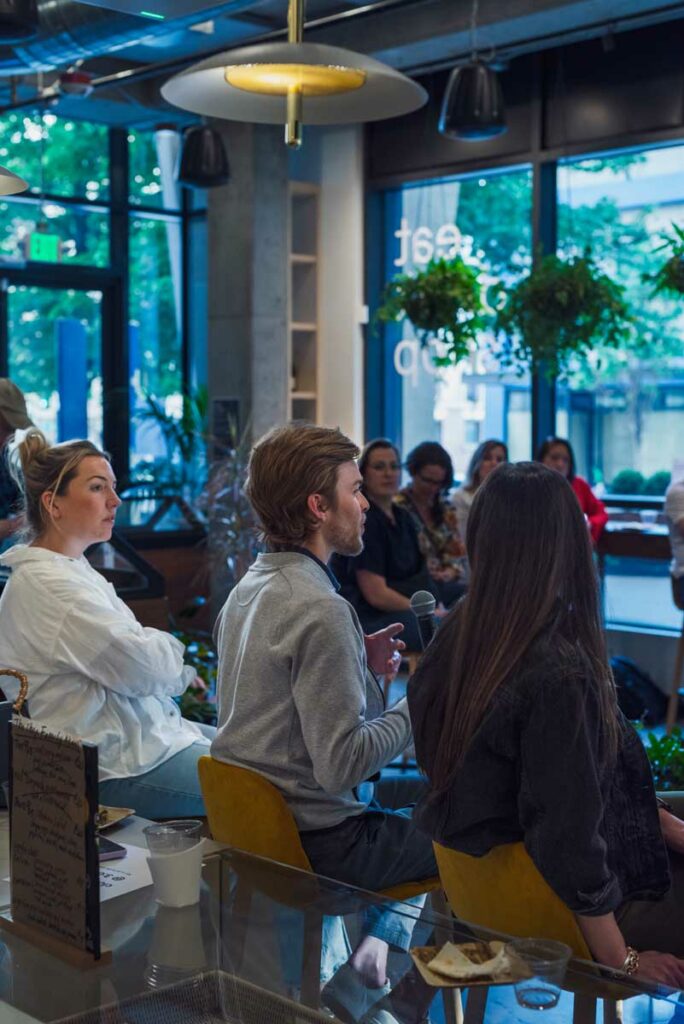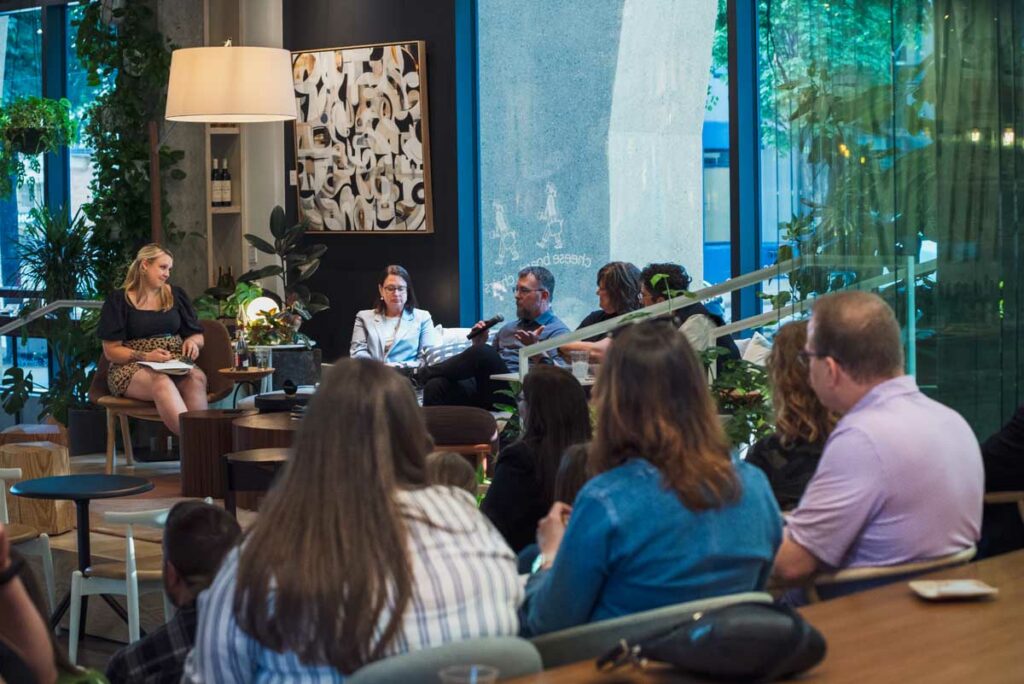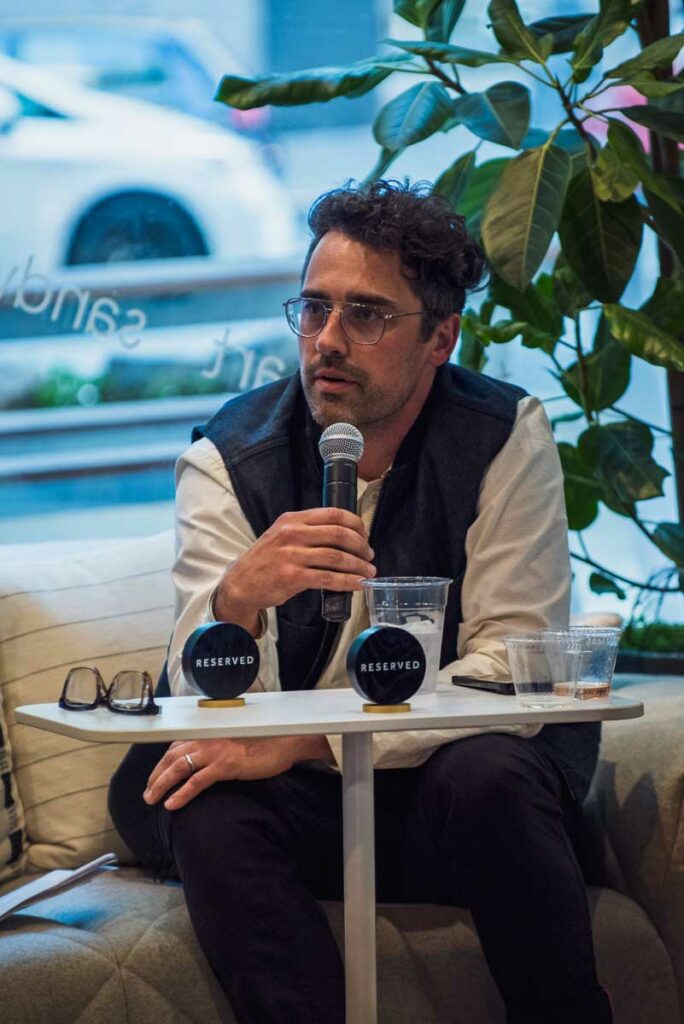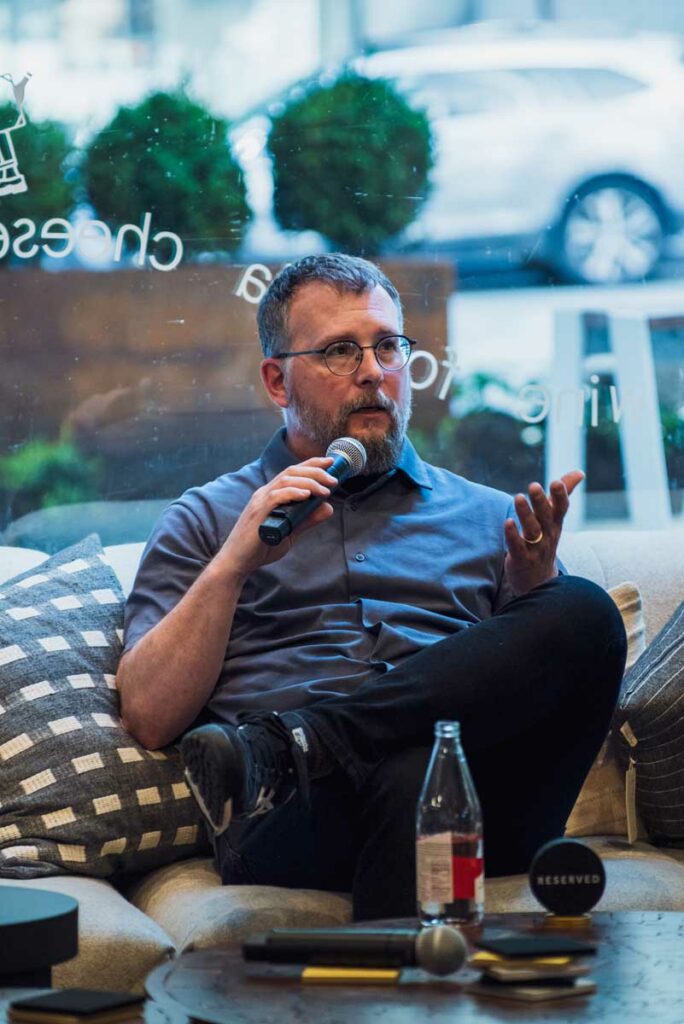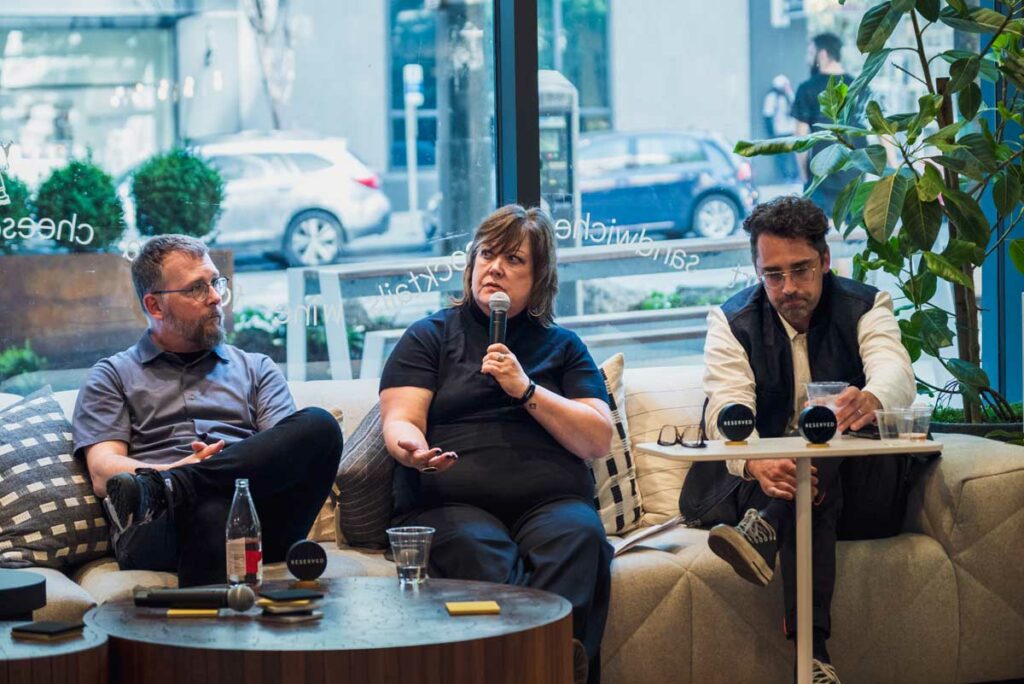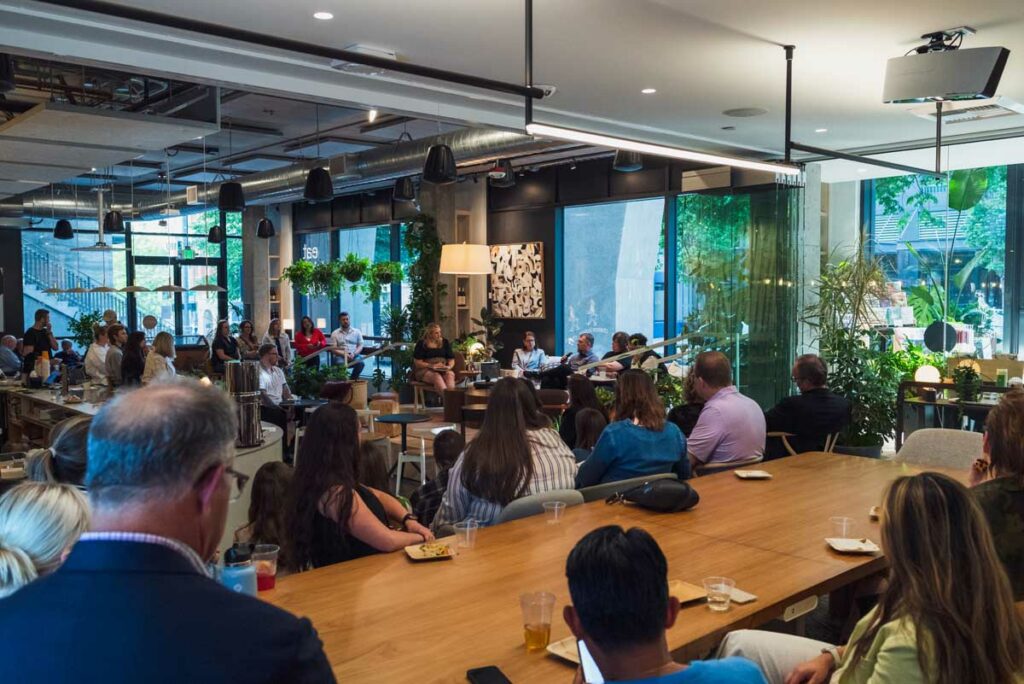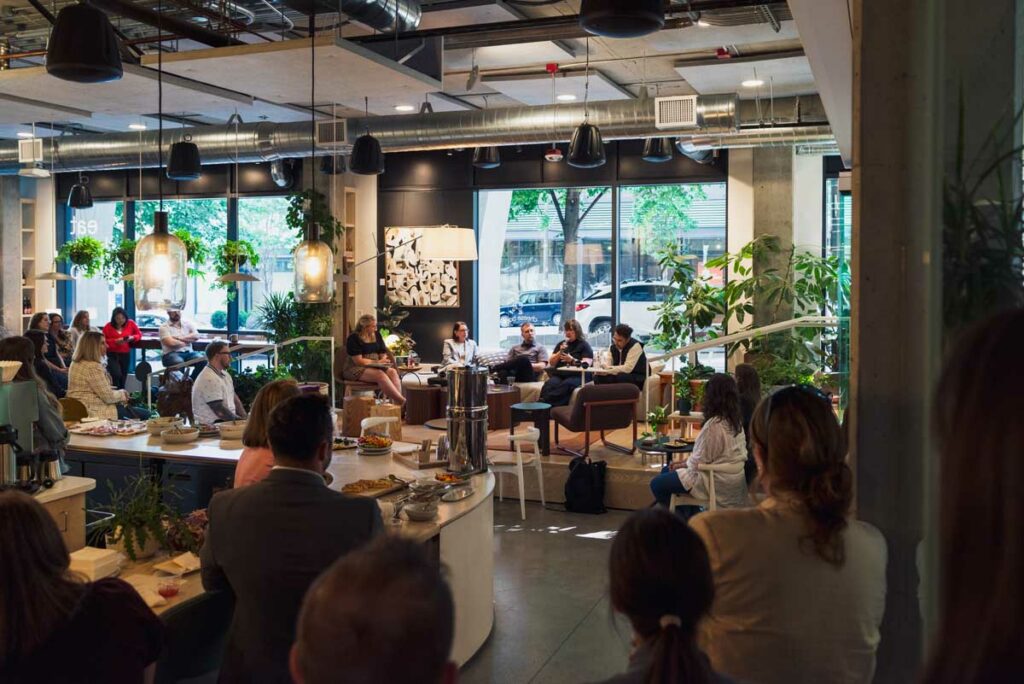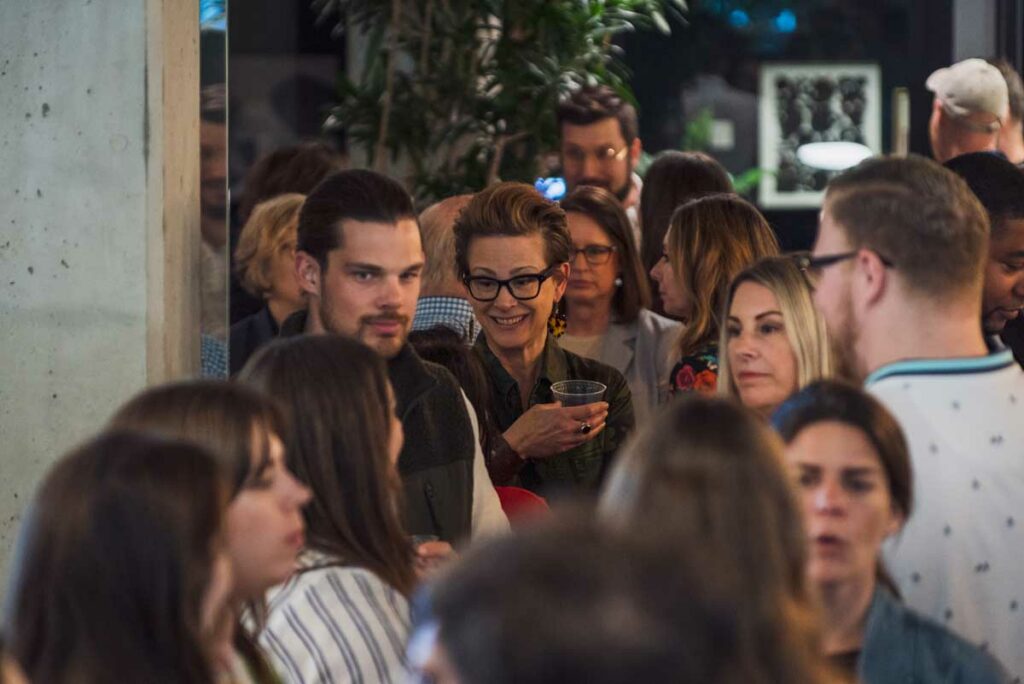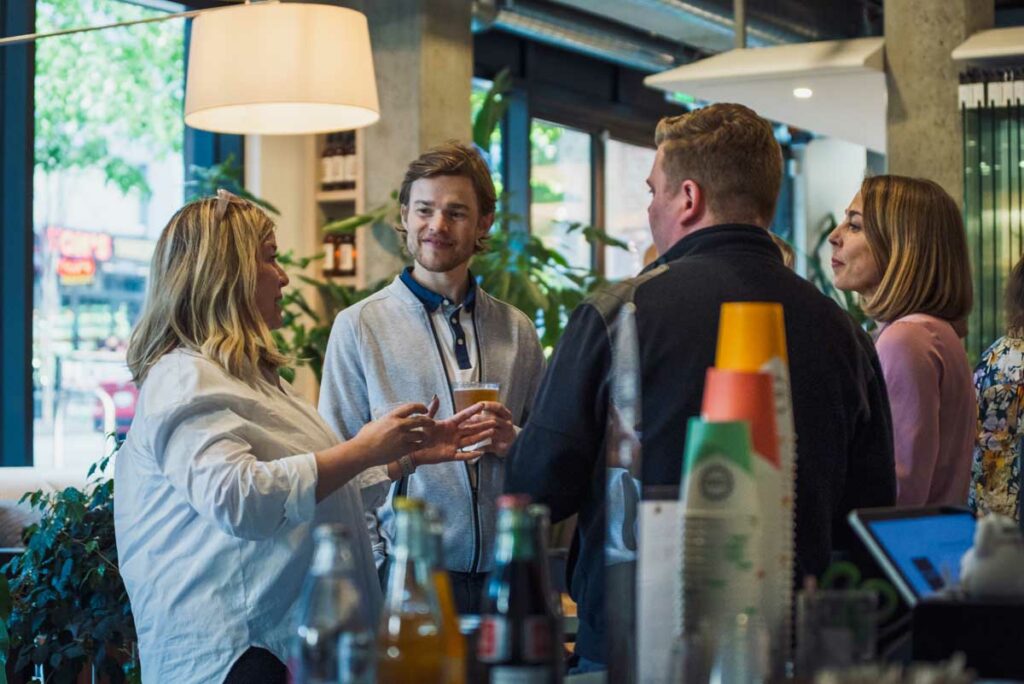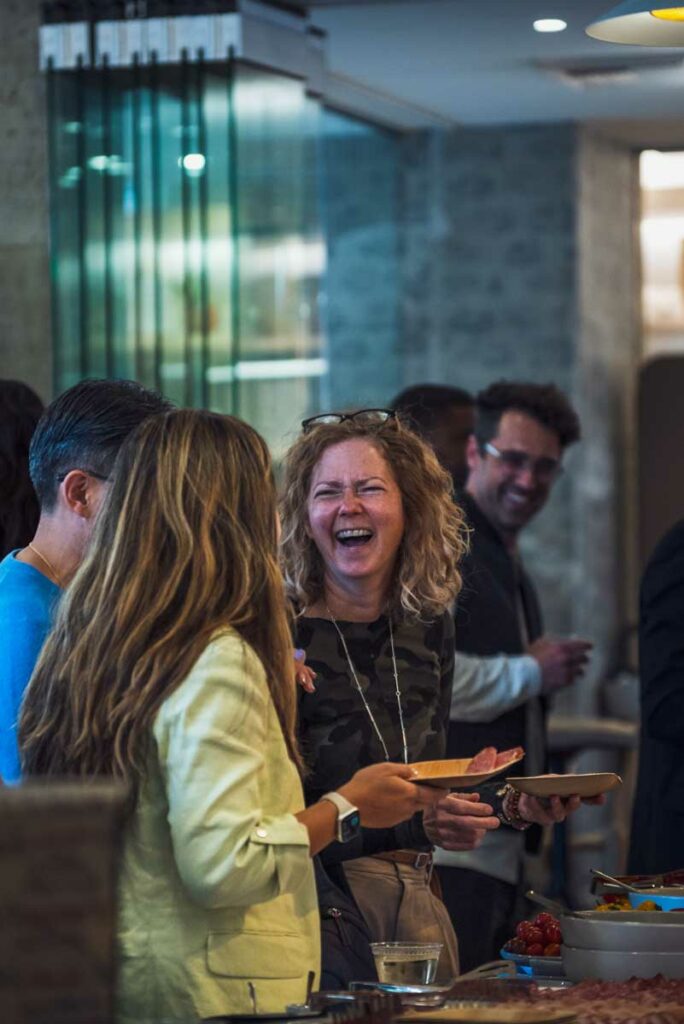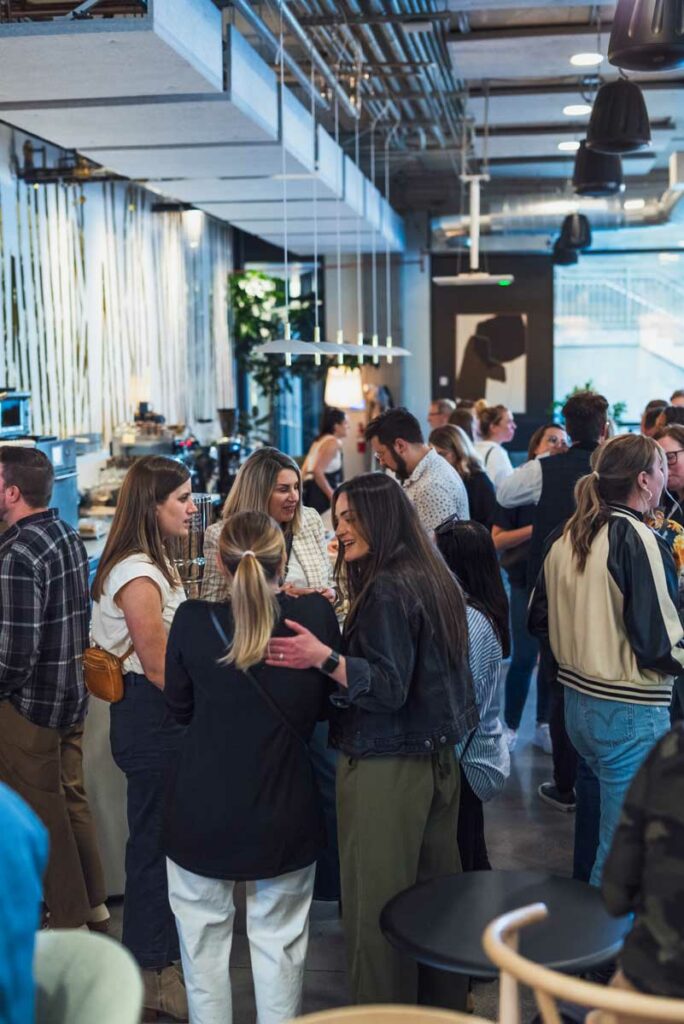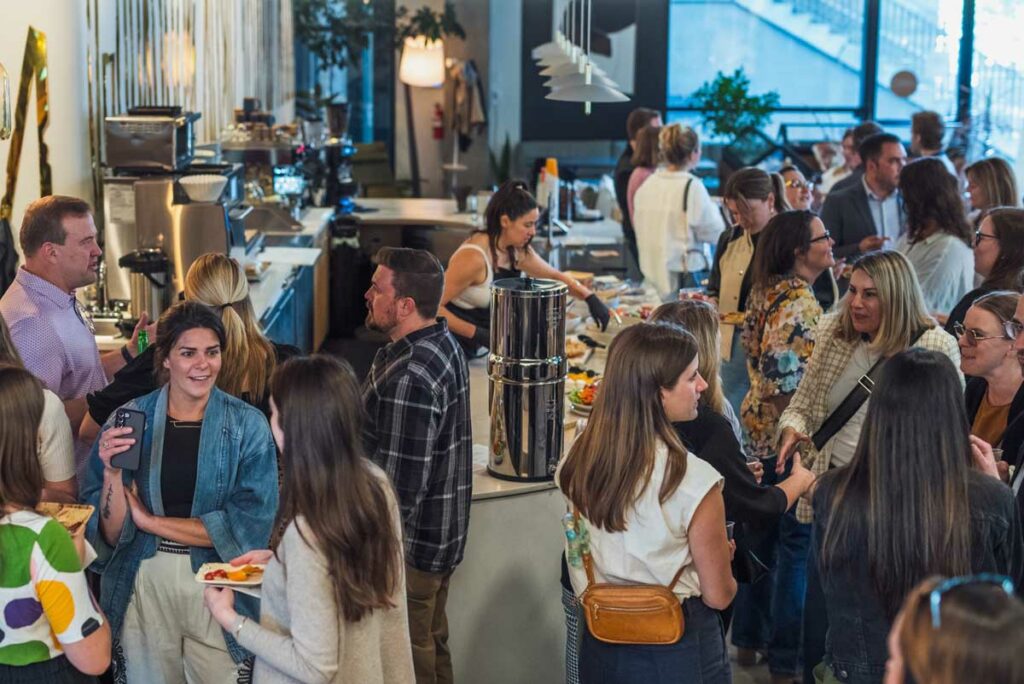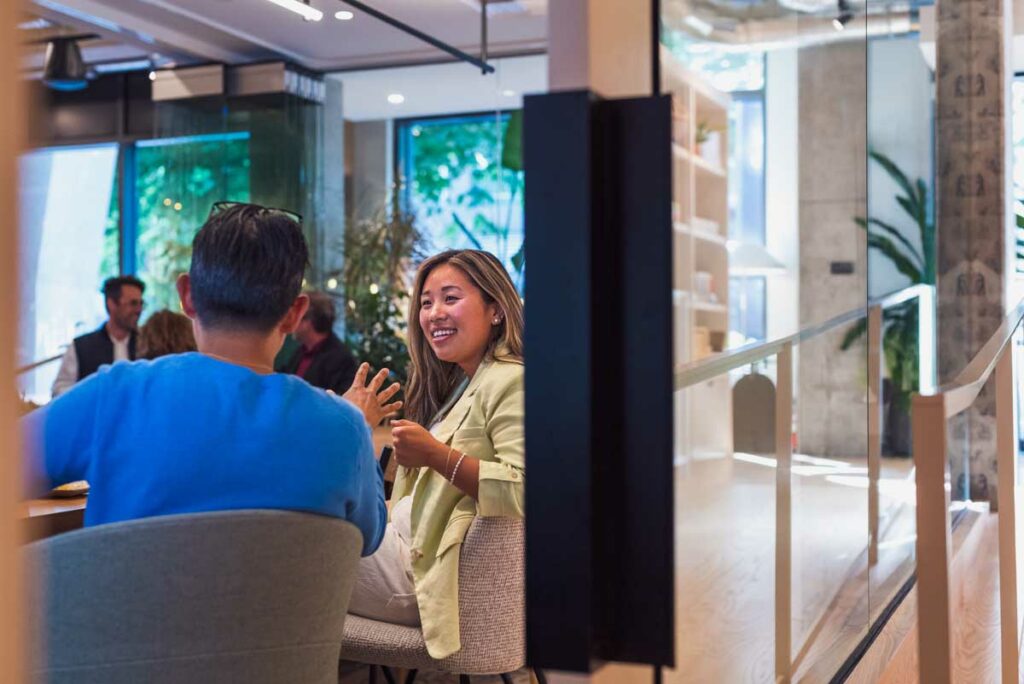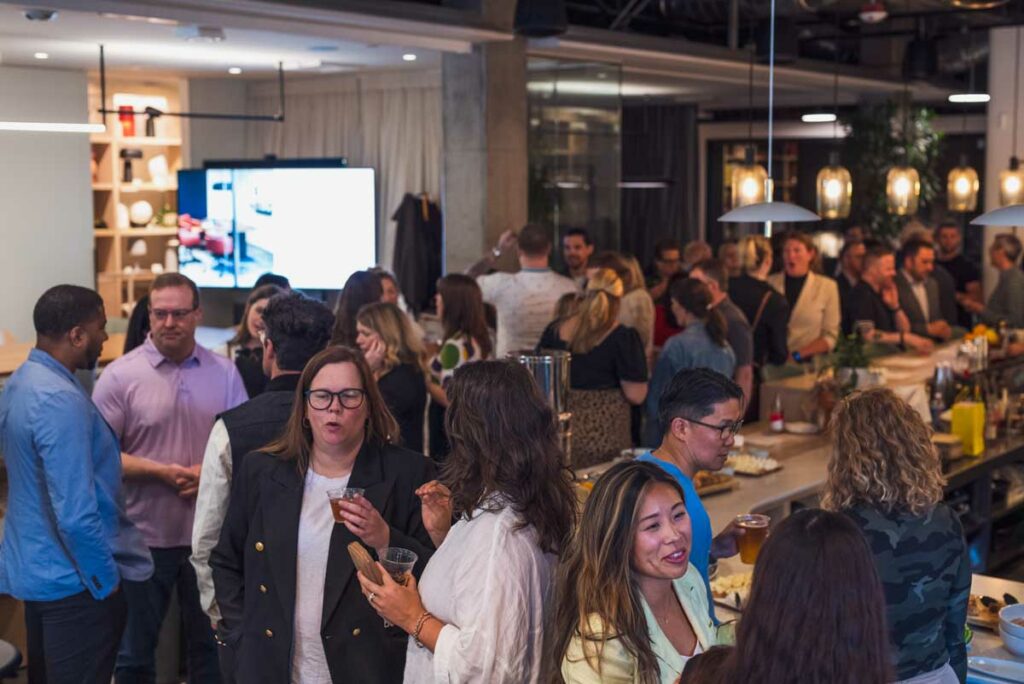The era of hybrid work, driven by remarkable technological advancements, is reshaping the way we work. But what does this future hold? Porter, in collaboration with Steelcase, OpenSquare, and One Workplace, hosted an engaging event at the Shop by Porter, where industry leaders gathered to delve into this prominent question. We were honored to welcome esteemed panelists Christina Vernon and Patricia Kammer from Steelcase, Stewart Germain from Skanska USA, and Jacob Riley Simons from Gensler. Guided by the expert moderation of Emily Heath from Boldly Belonging, the discussion revealed inspiring insights about human-centered workspaces in the hybrid environment, and set the stage for future exploration of this essential topic. Read on for highlights below.
On the key benefits and drawbacks of hybrid work models both for employees and organizations:
JACOB: We know that people got agency [working remotely during the pandemic]. New parents got to spend time with their family. That was me: my three-year-old was zero and new on the scene so that was my win and every parent with young kids experienced that. We gained time, which is one of the most precious resources, when we lost a commute. We saw relationships restored because time was prioritized. I could go on and on for a week about all the benefits, but it comes down to agency. It came down to learning, to new experiences, open mindset, all those things I think forged a path towards a lot of growth.
PATRICIA: We’re in the era of attention. People were given autonomy and they found agency. I think what’s equally important is people were seen for the first time ever because they were on video conference calls. Oftentimes what we would hear from people is like, I’m seen. Where you place your attention is very, very critical. And I don’t use the words intention, I say attention, right? Because I can intend to do many things, but if I don’t put my effort into it, then I am not putting my attention there. So, the answer about what are the things that drive people back to the office, or what are these new values, what I would say is that work needs to work. The workspace has to work. Coming back, they’re looking for space and tools, but also for the workspace as a place for socializing with purpose. Organizations and ideas do not move themselves. They move by people. And the number one reason why people tend to come back for ‘the work’ is because of the purpose. So, this purpose-driven organization is the number one reason people come back.
On designing a hybrid work strategy that is tailored to representing organizations’ and their employees’ values in the built environment:
STUART: I think a lot of it comes to a more heightened awareness of humanity and a variety of experiences. Early on for me in lockdown, I was able to make progress on things that were already going remotely, but if I wanted to start something new and creative and go a different direction, I really felt like a loss, like, looking at a screen. So I think the design comes from understanding there’s different types of working and different times of day and different phases of your sort of work environment. And so I think the real question for designers is, how do you create all this variety of spaces and still do so really in an efficient and functional way?
JACOB: What we were really dealing with was a systems challenge that was quite dynamic. It’s not only to talk about our intentions around how we convene, and for what purpose, and what activities do we value in person or at home, but we were dealing with tech and policy and social agreements and norms that had been there forever being just kind of decomposed overnight. So I appreciated that we were taking responsibility for more than we were before, and welcoming in the complexity of the conversation that was already there, but being kinda ignored.
CHRISTINA: I think as people started to come back to the office and back into space and collaborating, everyone realized they missed that connection. We want a better experience. And so we started to think about what are the pain points of the technology? What have we created by having to have every conversation through a Team or a Zoom call? How do we actually get up from our computers and from our PCs and really engage and collaborate in space? And just make sure that people are collaborating, being innovative, like as humans in space again. Let’s have a conversation. Let’s find those little serendipitous times again when we’re back in the office. So I think it’s just making sure that our spaces are working better than just, you know, joining a meeting from home.
On thriving in a hybrid environment and making sure it’s accessible:
STUART: I think Porter’s a great example of this. People got used to being able to sit on a couch and work on their laptop. They don’t have to stay home to sit on a couch. You can do that in the lobby or at the work lounge or the roof deck or whatever it is if you need to get away from your space. You know, people don’t want to be benched anymore. You’re going to take a call or you want to meet somebody, maybe you want to get out of your office, or your apartment. So we’re really seeing that blending back and forth. And that’s what we’re seeing people are really excited about. That’s what’s bringing them back to the office. They want to be at home at work sometimes, and they want to be at the office at work sometimes. But they don’t necessarily want those experiences to be totally different.
On how people are promoting work-life balance in this hybrid place:
PATRICIA: I tend to say we are living in the era of the mind, body, and spirit, which is why these beautiful places, these plants around us, relate to us. Adopting community spaces and affording them with beautiful artwork that connects to your heart, to your soul, those are the kinds of experiences that people are craving. The other thing relative to work-life balance is an organization that cares about them. It’s much more of a symbiotic relationship between the employer and the employee, which means it’s not just about giving me health care. It means that when I’m there, you deeply care about me. I think those are the conversations that we need to have, and those are the ways in which ‘the space’ can nurture this sort.
STUART: We recently completed a study about hybrid office, specifically targeting Gen Y and Gen Z, and Gen Z and Gen Alpha are just so much more to the point of universal design, so much aware of everything and respectful of everything, that they’re just going to demand a totally different environment. It’s not really the decision makers who are in place now, the Gen Xers like myself, or the Boomers; they’re going to fade out. So if you really want to look for where things are going next, it’s kind of our youth, right? What are their priorities, and then how do we align our spaces and our changes with their priorities?
CHRISTINA: We’re going to learn a lot from this generation that’s been through this, and they’re going to continue to push us to be, I think, better at solving work problems. They’re going to want to be in the office sometimes, and they’re going to want to work in any time frame. They’re also kids who think the eight to five seems so unstructured, like, so ridiculous to them. Why don’t you just go to work when you need to work? I think these younger generations will be there to kind of support us along the way.
PATRICIA: I don’t think anyone’s going to go back five days a week unless it’s mandated. I think we’re entering into a new era. It’s an individual negotiated decision. For me, it’s very different than for somebody who has children or for somebody who might be watching an elderly person. Work is going to be much more fluid. You’re going to come in in the times that you need and you’re going to leave. You will not stay captured from 8 until 5. You’re going to be intentional and things are going to be orchestrated.
On communicating this need for humanity to the C-suite:
STUART: I think that’s really kind of the nut of a question right now because we’re all having, like, feelings and intangible sorts of reactions to this, but data is often backwards looking. So, we need to start collecting the data to make the decisions to go forward. When we start to see patterns emerge, to see things happening, things settling down, then it’s like, okay, let’s capture this, let’s document it and then move forward to structure it.
CHRISTINA: I would say also it’s really about thinking through, like, what’s working and being able to document as people come back to the office. But making sure you have that sort of neighborhood of spaces so you can really document what’s happening and bring that back to your C-Suite to say, like, look, here’s what’s being used. Here’s what’s happening in these spaces. Here’s the length of time people are spending when they come in.
PATRICIA: I also think an organizational C-Suite is going to be concerned about their innovation. I think that the measure of productivity isn’t how hard people are working or the projects they’re getting done. What is the measurement for that organization as well? And I think if you can make an argument that that space is actually improving the collaboration or the culture, I think that would be where we start with that conversation. And measurement.
On asking for flexibility in a troubled economy:
JACOB: I’m all for agency. I’m absolutely asking all of my teammates, like, all hands on deck, the storm is real. Economically, we’re struggling. We’re resilient, but things aren’t going to get easier. So there’s nothing wrong with saying yes to agency. I see you, I’m working on things, cultivating the ability for people to question you and dissent, but also, all hands on deck, I need help. And if one of the things that really helps you get that done is being together more physically in place, that’s okay too. Those things can coexist. Part of this is the conscious leadership piece: being open minded, showing up as a listener and not being defensive. You could say servant leadership: measuring your own success as a leader based on the success of others and kind of investing in people in that way and really giving it your all. DE&I, sustainability, the planet, mental health, these are just some examples that are very prevalent in the conversation.
On the industries we rely on where work-from-home is not an option: What’s the new office for them?
PATRICIA: I guess what I would say is we still want to create compelling experiences for them too: a significant amount of inclusion, a great deal of flexibility, and a regenerative experience. I think those are the pillars that every organization is going to be about moving forward.
STUART: maybe what we do is, as architects and developers, we make those offices, those workplaces where people can’t work from home, the best freaking places available. And then people who are working at home look around like, I want to go work in an office because look how awesome that is. I mean, that’s what we have control of, right?
